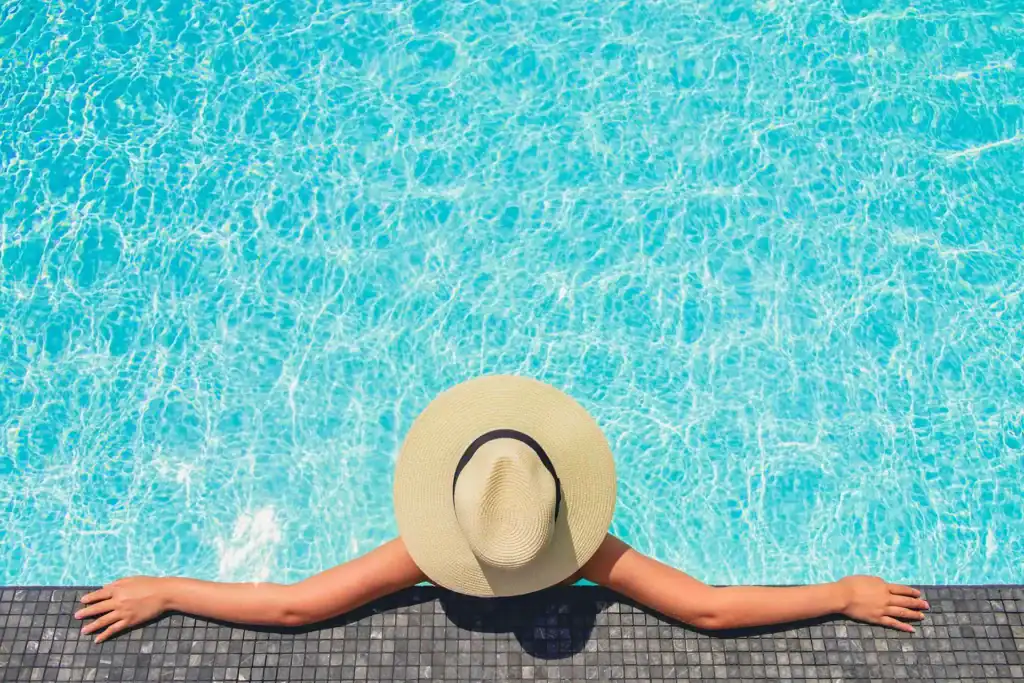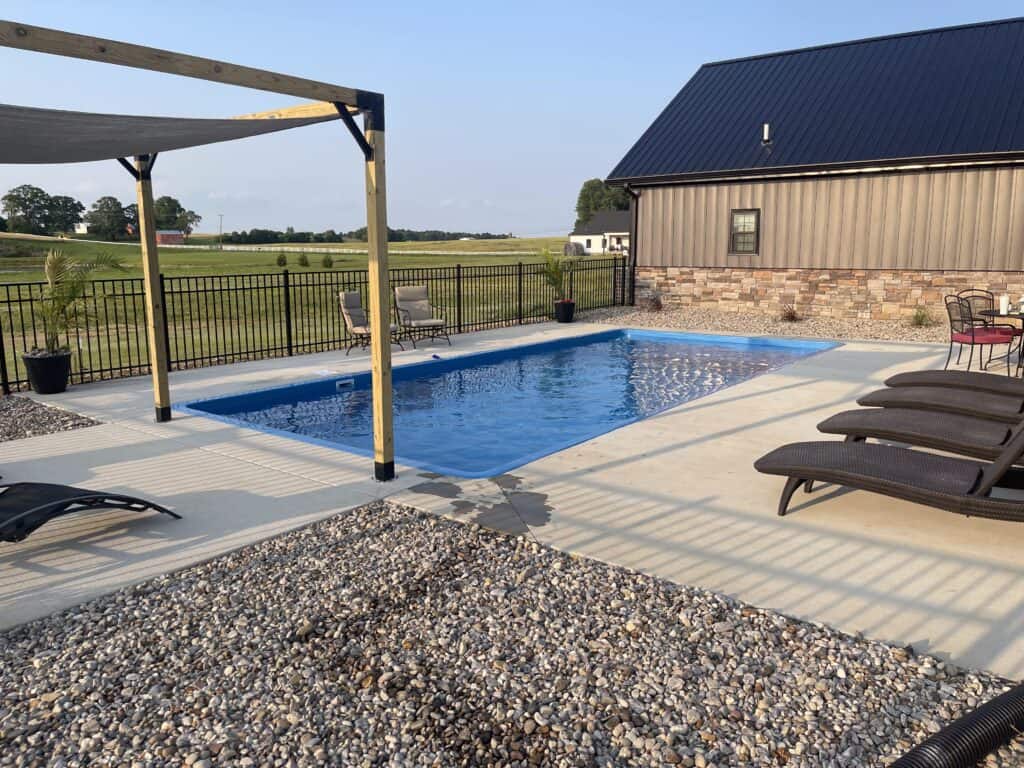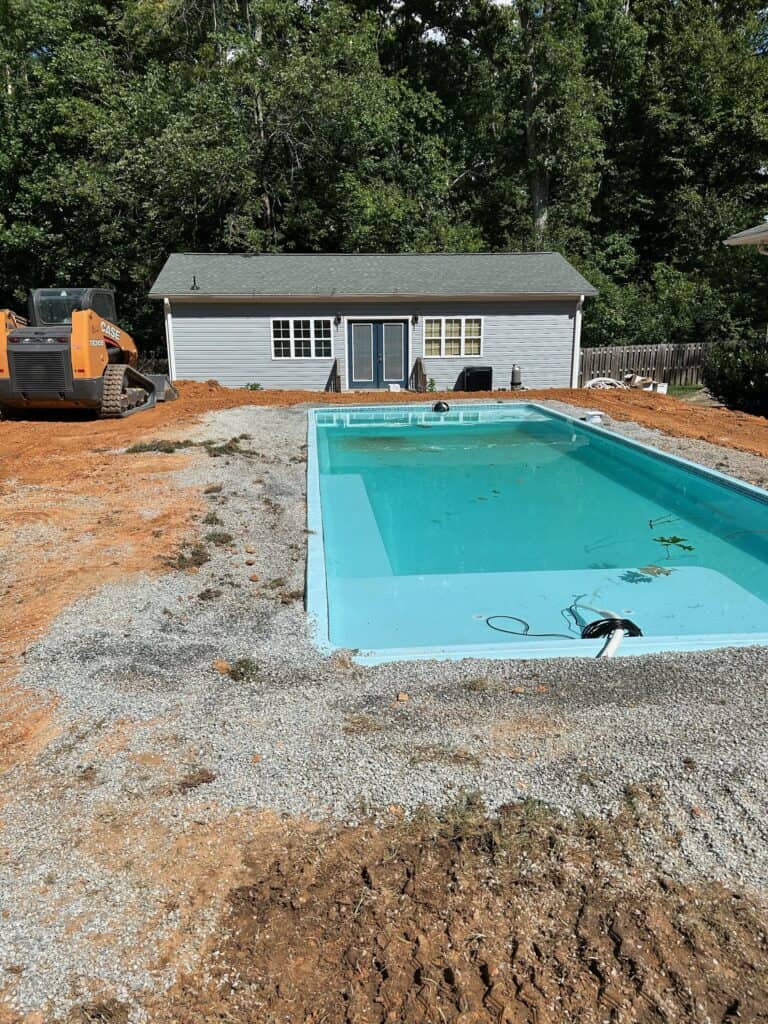Dreaming of a backyard oasis but worried about fiberglass inground pool cost? Understanding what drives these expenses can save you thousands while helping you create the perfect swimming space for your family.
The difference between an affordable fiberglass pool project and one that breaks the bank often comes down to seven key factors that many homeowners overlook until it’s too late. Let’s dive into what really determines your investment and how to make smart choices at each step.
Contents
Understanding Fiberglass Pool Investment
Fiberglass inground pool cost can vary widely based on factors like size, location, and the chosen contractor. These pools arrive as pre-manufactured shells, offering faster installation and lower lifetime maintenance than concrete or vinyl options. The wide price range exists because each installation is unique, influenced by several key factors that can either increase or decrease your total investment.
7 Factors That Affect Cost
1. Pool Size and Shape
The dimensions and design of your fiberglass pool significantly impact the final price tag. Small pools tend to be less expensive to install than larger models, which can require a bigger investment.
Standard rectangular shapes are more affordable than freeform designs with curves and custom features. Each additional foot in length or width increases material costs and requires more excavation, backfill, and labor.

Medium-sized swimming pools often provide the best balance between usable swimming space and budget considerations.
2. Site Preparation and Access
Your property’s unique characteristics can dramatically affect installation costs. Sloped yards may require extra excavation or retaining walls, which can increase overall project expenses.
Access challenges like narrow side yards or overhead obstacles can increase costs by requiring specialized equipment or manual labor. Properties with utility lines, large trees, or existing structures in the installation area will incur additional preparation expenses.
Site conditions that increase costs:
- Rocky soil requiring specialized equipment
- Limited access requiring crane installation
- Underground utilities needing relocation
- Drainage issues requiring additional solutions
Level lots with easy access typically result in the most affordable installations.
3. Features and Upgrades
The amenities you choose can transform a basic pool into a backyard resort—but each upgrade affects your bottom line. Tanning ledges, built-in steps, and beach entries can increase the overall price depending on the design and materials.

Water features like waterfalls, fountains, or bubblers add extra visual appeal and cost. Advanced options such as salt systems, automation controls, and premium lighting packages can significantly impact your total investment.
Integrated spas, hot tubs, and other building accessories represent some of the more substantial upgrades, raising the total pool cost based on size and features.
4. Decking and Landscaping
The area surrounding your pool significantly impacts both aesthetics and total project cost. Concrete decking is generally more affordable, while premium materials like pavers or natural stone can increase the price.

A well-designed decking area provides sufficient room for walking and seating around the pool. Landscaping elements create your backyard’s atmosphere but add to the budget.
Popular decking options and approximate costs:
- Brushed concrete: $6-10 per square foot
- Stamped concrete: $12-18 per square foot
- Pavers: $15-25 per square foot
- Natural stone: $25-40+ per square foot
Fencing requirements must also be included in your planning to meet safety regulations and maintain privacy. For instance, the state of Georgia requires fencing to be including in your pool permit application. Surrounding features and enhancements can represent a significant portion of the total project cost in any location.
5. Regional Labor and Permitting
Where you live significantly influences your fiberglass pool investment. Labor rates vary by region, with metropolitan areas typically commanding higher installation costs than rural locations.
Local building codes and permit requirements also affect your bottom line. Permit fees range from a few hundred to several thousand dollars depending on your municipality.
Some regions require additional safety measures, inspections, or engineering reports that increase overall costs. Seasonal demand in your area may also impact pricing and scheduling availability.
6. Installation Package Level
The installation approach you choose dramatically affects your fiberglass inground pool cost. Full-service installations, where the company handles everything from permits to landscaping, can be more expensive but often provide added convenience and comprehensive warranties.

Partial installation packages, where you handle certain parts of the project, can help lower costs. Working with companies like Pool Brokers USA that offer flexible installation options allows you to match your budget with your comfort level.
Taking on more project management responsibility can yield significant savings while still ensuring professional guidance for critical installation phases. Each approach offers different benefits depending on your budget, timeline, and DIY capabilities.
7. Ongoing Maintenance and Utilities
The long-term costs of pool ownership should factor into your initial decision-making. Fiberglass pools generally have lower chemical and maintenance costs compared to other pool materials.
Energy expenses for pumps, heaters, and lighting can vary depending on factors like climate and usage. Fiberglass pools rarely need resurfacing, unlike concrete pools which require expensive renovations every 10-15 years.
Long-term savings with fiberglass:
- No liner replacements (saving $4,000-$6,000 every 7-10 years)
- No resurfacing (saving $10,000-$20,000 every 10-15 years)
- Reduced chemical usage (saving $300-$500 annually)
- Lower electricity costs due to smoother surface
This long-term durability represents substantial savings over your pool’s lifetime. Investing in energy-efficient equipment initially can reduce ongoing utility expenses by 20-40%, making your pool more affordable to operate year after year. View our guide on Fiberglass Pool Maintenance: Care & Cleaning Tips to learn more about these expenses.
Next Steps to Estimate Your Pool Project
Request detailed, itemized quotes from reputable fiberglass pool suppliers like Pool Brokers USA to understand exactly what’s included in each package. Compare not just the bottom-line price but the quality of materials, warranty coverage, and installation support provided.
Ask specifically about what’s not included to avoid surprise expenses later. Explore financing options if needed, as many homeowners finance their pool projects through home equity loans or specialized pool financing.
Create a realistic timeline that accounts for permitting, manufacturing lead times, and installation scheduling. Most fiberglass pool projects take 2-4 weeks for installation once materials arrive, but the entire process from contract to completion typically spans 2-4 months. Because of these delays in timelines, we highly recommend beginning your pool installation journey in the winter months.
Moving Forward With Your Fiberglass Pool Dreams
Understanding these cost factors empowers you to make informed decisions about your fiberglass pool investment. By carefully considering each element and prioritizing features that matter most to your family, you can create a beautiful backyard retreat that fits your budget.
Fiberglass pools offer exceptional value through their durability, low maintenance requirements, and stunning appearance. Taking the next step is simple—request a quote from Pool Brokers USA to explore options tailored to your specific backyard and budget.
Our transparent pricing and flexible installation approaches help make the dream of pool ownership attainable for more families. Your perfect backyard oasis may be more affordable than you think when you work with the right partner.
